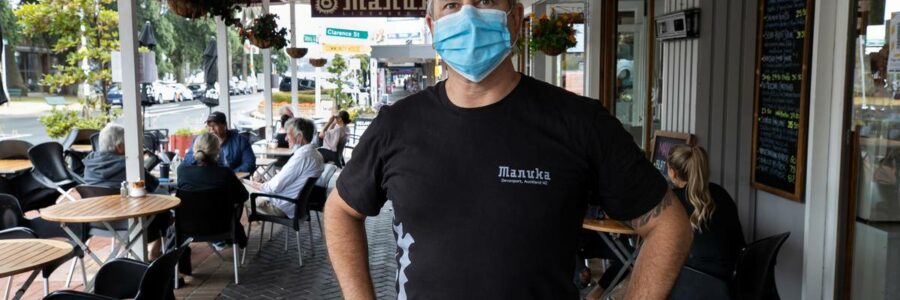
Covid 19 Omicron: Government to announce next stages of the fight against new variant
The Government will today reveal how it will try to step up the fight against Omicron as the highly infectious Covid-19 variant spreads across the country.
Prime Minister Jacinda Ardern has announced further measures, including new mask mandates and increased use of rapid antigen tests (RATs).
The Government has also boosted PCR testing, or nasal swabs, to a surge capacity of 78,000 a day – with ability to maintain that level for up to seven days.
This traditional test and trace approach will be the focus of phase one of the Omicron response, with phases two and three to be announced by Associate Health Minister Ayesha Verrall today, including how critical workers who are close contacts will be able to use RATs instead of self-isolating.
Ardern, speaking to media after a Cabinet meeting yesterday, said as part of the first phase of combating Omicron, in the red setting masks must now be worn at businesses that serve food and drink.
Face coverings must also now be “actual masks”, and workers mandated to be vaccinated must now also wear a “medical grade mask”.
Otago University epidemiologist Professor Michael Baker welcomed new mask rules, but added they still didn’t go far enough.
Baker said an equity problem could arise where some families couldn’t afford the highest quality ones.
“This is really where the Government has a big role to play, in stating standards and also enabling more access to suitable, quality masks. More needs to be done on both of those things in the time that we still have available.”
Owner of Devonport’s Manuka Cafe & Restaurant Peter Reeves said he was worried the mask protocol changes would discourage the public from visiting cafes and bars.
“It’s going to put people off coming out, my weekly take is going to go down and I’ve got no access to any support this time round, so from a business point of view, I’m extremely nervous.
“All these little things are getting drip-fed to us. Trying to keep up with all the rules is tricky. Then I have to educate my customers every day about it.”
The first phase in the fight against Omicron would continue the same testing, tracing and isolation settings as before, with PCR capacity boosted from 39,000 a day to 58,000, andthe ability to surge to 77,600 tests where necessary for a seven-day period.
Director general of health Dr Ashley Bloomfield said those figures were based on pooling testing. This involved pooling a group of samples that were likely to be negative together and running them as one test, effectively boosting testing capacity.
However, as the proportion of positive results grew – in Australia it has got to over 30 per cent – and each test needed to be run individually, this pooling ability was affected.
Bloomfield said the singular daily testing capacity was about 38,000 tests a day.
As the outbreak grew, the next phases of the response would include using RATs, for community transmission and for critical workers who were close case contacts so they could continue working without needing to self-isolate – a “Test to Return to Work approach”.
There were 4.6 million RATs currently in the country, and 14.6 million more were expected over the next five weeks, Ardern said. A potential 22 million would also arrive over the same period.
Baker said the Government’s position to keep using PCR tests for current testing, and use rapid antigen testing when the outbreak widened, made sense.
“At the moment, we are still treating Omicron like Delta, which is absolutely the right thing to do, given we still have plenty of capacity for testing, and we’re still able to contact trace,” he said.
“Rapid antigen testing will be very important when we’re absolutely awash with Omicron.”
New Zealand Institute of Medical Laboratory Science president Terry Taylor told Newstalk ZB he was skeptical of the PCR testing capacity, saying he thought 60,000 a day was more believable.
In Australia daily testing capacity had been affected within days of widespread community transmission, based on pooling issues, but also as lab workers themselves became infected.
Once Omicron was widespread in the community RATs would be essential, Taylor said, and he was interested in Verrall’s announcement today to hear how that would proceed, and how laboratory staffing would be managed as people got sick.
Ardern also said despite community transmission of Omicron the Government was sticking to its staged plans to reopen the border from late February, with specific dates to come after the next two meetings of Cabinet.
Yesterday, 25 new cases of Covid-19 were reported in the community, including 10 new Omicron cases and the variant has appeared in Tauranga after earlier being detected in Auckland and Motueka.
Hipkins also announced yesterday the Government ordered 5000 portable air cleaners, to ensure schools were ventilated enough to help prevent the spread of Covid-19.
– Additional reporting: Julia Gabel, Jamie Morton
Source: Read Full Article
/cloudfront-ap-southeast-2.images.arcpublishing.com/nzme/V7DVRWHE77QVLRMR2KSNDJZBKU.jpg)
/cloudfront-ap-southeast-2.images.arcpublishing.com/nzme/DJDC4Z7UP3F2GDKOACH47XYLSY.jpg)
/cloudfront-ap-southeast-2.images.arcpublishing.com/nzme/IJFPEMWKJJ6GT4YUSAOXWHR6XE.jpg)